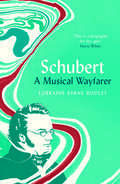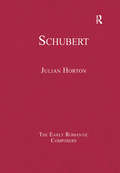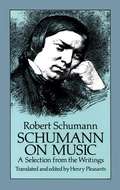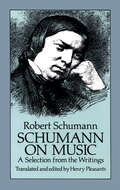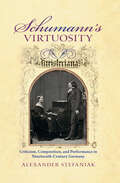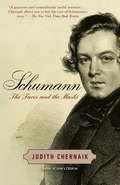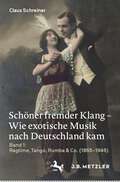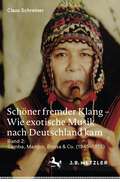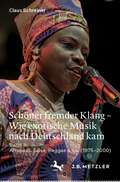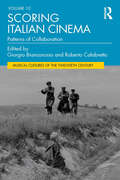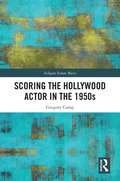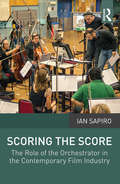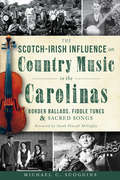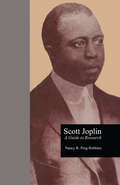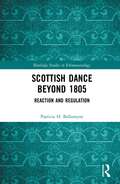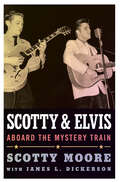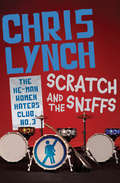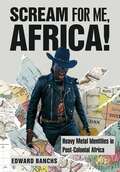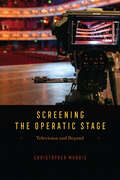- Table View
- List View
Schubert: A Musical Wayfarer
by Lorraine BodleyAn insightful biography of the great composer, revealing Schubert’s complex and fascinating private life alongside his musical genius Brilliant, short-lived, incredibly prolific—Schubert is one of the most intriguing figures in music history. While his music attracts a wide audience, much of his private life remains shrouded in mystery, and significant portions of his work have been overlooked. In this major new biography, Lorraine Byrne Bodley takes a detailed look into Schubert’s life, from his early years at the Stadtkonvikt to the harrowing battle with syphilis that led to his death at the age of thirty-one. Drawing on extensive archival research in Vienna and the Czech Republic and reconsidering the meaning of some of his best-known works, Bodley provides a fuller account than ever before of Schubert’s extraordinary achievement and incredible courage. This is a compelling new portrait of one of the most beloved composers of the nineteenth century.
Schubert: History, Theory, Style (The\early Romantic Composers Ser.)
by Julian HortonThe collection of essays in this volume offer an overview of Schubertian reception, interpretation and analysis. Part I surveys the issue of Schubert�s alterity concentrating on his history and biography. Following on from the overarching dualities of Schubert explored in the first section, Part II focuses on interpretative strategies and hermeneutic positions. Part III assesses the diversity of theoretical approaches concerning Schubert�s handling of harmony and tonality whereas the last two parts address the reception of his instrumental music and song. This volume highlights the complexity and diversity of Schubertian scholarship as well as the overarching concerns raised by discrete fields of research in this area.
Schubert: The Complete Song Texts
by Richard WigmoreThis is a complete collection of Franz Schubert's solo songs in German originals with English translations. A small number are in Italian with English translations. Schubert's songs are the most frequently performed of the whole vocal repertoire, and, for many people, the best loved. They range from the very short--lasting barely two minutes--to immensely long ballads, and scenas which are virtually cantatas. Schubert was among the most prolific of composers, having written (in addition to a large output of symphonies, sonatas, quartets, masses and operas) more than 600 songs by the time of his death in 1828 at the age of 31. Almost all his songs are settings of German poetry, but a few use Italian words, and the texts of several are German translations of English poetry and prose by Sir Walter Scott, Shakespeare, James Macpherson (Ossian) and others. Schubert composed more than a hundred settings of Goethe, the greatest of all German poets, and many of these are among the finest and best loved of his songs. But he also set the work of other major German poets of the 18th and early 19th centuries. The most famous of the songs have appeared in previously published volumes of Lieder texts, such as The Penguin Books of Lieder and The Fischer-Dieskau Book of Lieder; but more and more, these days, singers are discovering the beauties of the less familiar songs, and adding them to concert programmes and recordings. This book fulfils the growing need for parallel texts and translations of all the songs, and is the first in its field. The prose translations, keeping as close as possible to the originals, are most sympathetic, and readable in their own right, and will be invaluable to the singer with little or no German, as well as a delight to the many music-lovers who listen to these songs on radio, on record and at concerts. This electronic edition is formatted with a line of English translation below each line of German original and is DAISY formatted with each song at level 1.
Schumann on Music: A Selection from the Writings
by Robert Schumann Henry PleasantsIncludes 61 important critical pieces Schumann wrote for the Neue Zeitschrift fur Musik 1834-1844. Perceptive evaluations of Beethoven, Chopin, Schubert, other giants; also Spohr, Moscheles, Field, other minor masters. Annotated.
Schumann on Music: A Selection from the Writings (Dover Books On Music: Composers)
by Robert Schumann Henry PleasantsSchumann's genius as a composer is well known; perhaps less well known is the fact that he was also a gifted music critic who wrote hundreds of perceptive essays, articles, and reviews for the Neue Zeitschrift fur Müsik, the influential music journal he founded in 1834.The present work, translated and edited by noted critic Henry Pleasants, contains 61 of the most important critical pieces Schumann wrote for Neue Zeitschrift between 1834 and 1844. The articles are arranged in chronological order, with ample annotation, demonstrating not only Schumann's development as a writer and critic but also the evolution of music in Europe during a decisive decade.In addition to such major set pieces as "Florestan's Shrovetide Oration," the essays on Berlioz's Symphonie Fantastique and Schubert's Symphony in C Major, and the imaginative and literate "The Editor's Ball," this volume offers discerning observations on Mendelssohn, Chopin, Beethoven, Liszt, Cherubini, and other giants. Also included are critical considerations of an ensemble of minor masters: Sphor, Hiller, Moscheles, Hummel, and Gade, among others. The result is a rich and representative picture of musical life in the mid-19th century.Schumann's criticism has long been famous for its perceptiveness and literary style. Those qualities are in ample evidence in this treasury of his finest critical writings, now available to every music lover in this inexpensive, high-quality edition.
Schumann's Virtuosity: Criticism, Composition, and Performance in Nineteenth-Century Germany
by Alexander StefaniakConsidered one of the greatest composers--and music critics--of the Romantic era, Robert Schumann (1818-1856) played an important role in shaping nineteenth-century German ideas about virtuosity. Forging his career in the decades that saw abundant public fascination with the feats and creations of virtuosos (Liszt, Paganini, and Chopin among others), Schumann engaged with instrumental virtuosity through not only his compositions and performances but also his music reviews and writings about his contemporaries. Ultimately, the discourse of virtuosity influenced the culture of Western "art music" well beyond the nineteenth century and into the present day. By examining previously unexplored archival sources, Alexander Stefaniak looks at the diverse approaches to virtuosity Schumann developed over the course of his career, revealing several distinct currents in nineteenth-century German virtuosity and the enduring flexibility of virtuosity discourse.
Schumann: The Faces and the Masks
by Judith ChernaikA groundbreaking account of Robert Schumann, a major composer and key figure of Romanticism, whose life and works have been the subject of intense controversy since his early death in a mental asylum.Schumann: The Faces and the Masks draws us into the milieu of the Romantic movement, which enraptured poets, musicians, painters, and their audiences in the early nineteenth century and beyond, even to the present day. It reveals how Schumann (1810-1856) embodied all the contrasting themes of Romanticism--he was intensely original and imaginative but also worshipped the past; he believed in political, personal, and artistic freedom but insisted on the need for artistic form based on the masters: Bach, Haydn, Mozart, and Beethoven. It details his deep involvement with other composers of his time, such as Chopin and Mendelssohn, Liszt and Brahms, as well as the literary lights of the age--Johann Wolfgang von Goethe, Heinrich Heine, E.T.A. Hoffmann--whose works gave inspiration to his compositions and words to his songs. Drawing on hitherto unpublished archive material, as well more established sources of journals, letters, and publications, Judith Chernaik provides enthralling new insight into Schumann's life and his music: his sexual escapades, his fathering of an illegitimate child, the facts behind his courtship of Clara Wieck--already a noted young concert pianist--his passionate marriage to her despite the opposition of her manipulative father, his passionate marriage, and the ways his many crises fed into the dreams and fantasies of his greatest works, turning his tumultuous life into music that speaks directly to the heart.
Schumann’s Music and E. T. A. Hoffmann’s Fiction
by John MacauslanFour of Schumann's great masterpieces of the 1830s - Carnaval, Fantasiestücke, Kreisleriana and Nachtstücke - are connected to the fiction of E. T. A. Hoffmann. In this book, John MacAuslan traces Schumann's stylistic shifts during this period to offer insights into the expressive musical patterns that give shape, energy and individuality to each work. MacAuslan also relates the works to Schumann's reception of Bach, Beethoven, Novalis and Jean Paul, and focuses on primary sources in his wide-ranging discussion of the broader intellectual and aesthetic contexts. Uncovering lines of influence from Schumann's reading to his writings, and reflecting on how the aesthetic concepts involved might be used today, this book transforms the way Schumann's music and its literary connections can be understood and will be essential reading for musicologists, performers and listeners with an interest in Schumann, early nineteenth-century music and German Romantic culture.
Schwelgen dürft ihr: Musikbezogene Affektstrukturen im Laien-Pop-Chor
by Anna RizziChöre sind aus der deutschen Laienmusikszene ebenso wenig wegzudenken wie Berichte über mit dem gemeinsamen Singen einhergehende Gefühle. Was allerdings spielt sich in der Proben-Praxis von Chören im Hinblick auf gefühlsbezogene Phänomene ab? Welche Strukturen zeigen sich, wenn Affektivität nicht im Sinne privater Gefühlszustände, sondern als sozial gewachsenes Tun verstanden wird? Diesen Fragen widmet sich das vorliegende Buch, in dem die Praktiken eines Laien-Pop-Chors ethnographisch und mit Fokus auf affektivem Geschehen beforscht werden. Die praxistheoretisch fundierte Arbeit fokussiert dabei vor allem darauf, wie affektive Zuschreibungen in den Chorpraktiken sichtbar und als Mittel der Probenarbeit routinehaft eingesetzt werden. Ein Schwerpunkt liegt auf affektbezogenen Ansagen und davon ausgehend auf der Frage nach dem praktischen Wissen, das die Sänger*innen zu kompetenten Teilnehmer*innen ihrer Chor-Praxis macht. Das Potential praxeologischer Emotionskonzepte für die empirische Untersuchung musikbezogener Praxen manifestiert sich in detaillierten Fallanalysen der beforschten Praxis, die deren Affektivität nicht nur empirisch greifbar machen, sondern sie zugleich auch auf produktive Weise entmystifizieren.
Schöner fremder Klang – Wie exotische Musik nach Deutschland kam: Band 1: Ragtime, Tango, Rumba & Co. (1855–1945)
by Claus SchreinerIn seiner großen Geschichte der ‚exotischen‘ populären Musik beschreibt Claus Schreiner den transatlantischen Weg all der uns heute vertrauten Musikstile von ihren Ursprüngen nach Europa und Deutschland. Er berichtet im ersten von drei Bänden, wann und wie es zu ersten Begegnungen von Europäern mit afroamerikanischen Künstlern kommt und wie Charleston, Ragtime, Jazz, Tango, Maxixe, Rumba, Biguine in Kolonialzeiten und in den Küstenstädten Lateinamerikas entstehen. Die Aufnahme, Anverwandlung und Amalgamierung der vielen fremden Musikstile in den Metropolen Europas wird im Hauptteil des Buches lebendig und mit vielen Künstlerbiographien, Songtexten und Geschichten beschrieben. Wie gingen die Deutschen zwischen Kaiserreich und NS-Staat mit den exotischen Tänzen und den Künstlerinnen und Künstlern um? Welche Rolle spielten Musikethnologie, Unterhaltungsindustrie, Zeitgeist und die Folgen von Krieg, Kolonialzeit und Nationalsozialismus? Das Buch zeichnet ein deutliches Bild von der überragenden Rolle der ‚exotischen‘ Musik für die populäre Kultur der Moderne.
Schöner fremder Klang – Wie exotische Musik nach Deutschland kam: Band 2: Samba, Mambo, Bossa & Co. (1945–1975)
by Claus SchreinerIn seiner großen Geschichte der ‚exotischen‘ populären Musik beschreibt Claus Schreiner den transatlantischen Weg all der uns heute vertrauten Musikstile von ihren Ursprüngen nach Europa und Deutschland. Der zweite Teil beginnt mit der Nachkriegszeit. Die Isolation Deutschlands von vormals verbannten ‚exotischen‘ Einflüssen endet. Träume von einsamen Inseln werden im Nachkriegs- und Wirtschaftswunderland nicht nur von einfältigen Schlagertexten, sondern auch von Samba, Baião und Bossa Nova aus Brasilien bedient, dann kommen Mambo und Chachachá aus New York und Kuba und der Calypso. Auf deutschen Bühnen zeigen Tanz-Ensembles aus den jungen afrikanischen Staaten, aus Brasilien, Mexiko und Korea Mischungen aus Folklore und Ballett. Aus den USA weht die Folk-Welle herüber und initiiert nicht nur Festivals wie Waldeck, sondern auch erste Begegnungen mit internationaler Folklore, denen Protestsongs mit den Krisen der sechziger Jahre folgen, an die sich in einer Welle der Solidarität Musik chilenischer Exilgruppen und der Künstler aus anderen lateinamerikanischen Diktaturen anschließt. Mit El Condor Pasa beginnt die Invasion der Poncho-Gruppen in die Fußgängerzonen.
Schöner fremder Klang – Wie exotische Musik nach Deutschland kam: Band 3: Afrobeat, Salsa, Reggae & Co. (1975-2000)
by Claus SchreinerIn seiner großen Geschichte der ‚exotischen‘ populären Musik beschreibt Claus Schreiner den transatlantischen Weg all der uns heute vertrauten Musikstile von ihren Ursprüngen nach Europa und Deutschland. Der dritte Band beginnt mit der Musik Afrikas und ihrer Ankunft in Europa. Back to Africa: Reggae-Wurzeln und die deutsche Szene, wo das Interesse nicht nur an den Urvätern des Reggae wächst. Man will mehr Originale erleben, traditionell oder populär, und schafft neue Festivals, die oft mit Workshops und Informationen begleitet werden. Das New Age-Zeitalter beginnt und lässt Musiker in esoterischen Quellen schöpfen. Japanische Trommelgruppen lassen Konzertsäle erbeben und Butoh-Tänzer erinnern an den Ausdruckstanz der zwanziger Jahre. Musik aus vielen ‚exotischen‘ Wurzeln bietet sich als Alternative zu Belanglosem in Spaßgesellschaft, Disco und Neuer Deutscher Welle und als Begleitung von Aktionen gegen Rassismus, Hungersnöte und Fremdenfeindlichkeit an. Salsa aus Puerto Rico und New York bringt endlich mehr Körperlichkeit in deutsche Tanzclubs und bereitet den Boden für nostalgisches Buena Vista-Feeling, das von Modetänzen wie Lambada, Merengue und Zouk abgelöst wird. Latinmusic sorgt auch in Deutschland für Hits. Am Ende des Jahrhunderts ist das Angebot überreichlich vorhanden und man nennt es Weltmusik.
Science and Music (Dover Books On Music Ser.)
by James JeansSir James Jeans, noted British scientist, has given a physical analysis of musical sounds, in what is considered to be the best exposition on the subject, a book of great intellectual stature. His aim has been to convey precise information, in a simple non-technical way, that will be of interest to the amateur as well as the serious student of music. The discussion begins with an explanation of the development of the human faculty of hearing. It is established that each sound can be represented by a curve. An examination of the general properties of sound-curves follows. For example, why do some sounds produce pleasure when they reach our ears and some pain? How do we retain the pleasurable qualities in the sound-curve, as it passes on from one stage of electronic equipment to another? To what extent is it possible to prevent unpleasant qualities from contaminating the curve? These and other pertinent questions on the transmission and reproduction of sound-curves are answered in a discussion of tuning-forks and pure tones. The various methods of producing sound, and the qualities of the sounds produced, are further discussed as they relate to vibrations of strings and harmonics, and vibrations of air. Harmony and discord are also considered. In the final chapters on the concert room and hearing, the discussion focuses on the transmission of sound from its source to the eardrum and from the eardrum to the brain. A general theory of acoustics is also covered as well as acoustical analyses.
Score and Rehearsal Preparation: A Realistic Approach for Instrumental Conductors
by Gary StithThis text is sure to provide the most practical approach to orchestra and wind band score study ever published. It methodically simplifies preliminary score study and initial rehearsal preparation for all conductors of band, orchestra and chamber ensembles. It is enormously valuable for practicing conductors from elementary school to those leading professional ensembles. As a supplement to undergraduate and graduate level instrumental conducting classes, it is an extremely effective text.
Scoring Italian Cinema: Patterns of Collaboration (Musical Cultures of the Twentieth Century)
by Giorgio Biancorosso Roberto CalabrettoScoring Italian Cinema: Patterns of Collaboration redefines what it means to write music for the cinema. In eight richly illustrated chapters and a deft introduction, nine leading music and film scholars revisit the great theme of artistic collaboration from a heretofore unexplored angle: the relationship between film directors and composers in the "Long Italian Post-War" (ca. 1945–1975).Spurred by the surfacing of printed and manuscript scores, sketches, drafts, tapes, letters and miscellaneous notes, the authors of Scoring Italian Cinema examine afresh the partnerships between such figures as Federico Fellini and Nino Rota, Michelangelo Antonioni and Giovanni Fusco, Elio Petri and Ennio Morricone, and Dario Argento and Goblin. The volume also brings to light the role of conductors and performers as well as producers and screenwriters in creating the soundtracks of some of the most important films in the history of Italian cinema, including Bitter Rice (Riso Amaro, 1949), La strada (1954) and Salvatore Giuliano (1962). The intrinsically polyvocal nature of the process of completing a score, such as it emerges in the case studies gathered in Scoring Italian Cinema, invites us to rethink of composing for the films as a new kind of expanded, distributed musical practice.Meticulously researched and written in an accessible style, Scoring Italian Cinema will appeal to scholars and practitioners in the fields of music, film and media studies.
Scoring the Hollywood Actor in the 1950s (Ashgate Screen Music Series)
by Gregory CampScoring the Hollywood Actor in the 1950s theorises the connections between film acting and film music using the films of the 1950s as case studies. Closely examining performances of such actors as James Dean, Montgomery Clift, and Marilyn Monroe, and films of directors like Elia Kazan, Douglas Sirk, and Alfred Hitchcock, this volume provides a comprehensive view of how screen performance has been musicalised, including examination of the role of music in relation to the creation of cinematic performances and the perception of an actor’s performance. The book also explores the idea of music as a temporal vector which mirrors the temporal vector of actors’ voices and movements, ultimately demonstrating how acting and music go together to create a forward axis of time in the films of the 1950s. This is a valuable resource for scholars and researchers of musicology, film music and film studies more generally.
Scoring the Score: The Role of the Orchestrator in the Contemporary Film Industry
by Ian SapiroScoring the Score is the first scholarly examination of the orchestrator’s role in the contemporary film industry. Orchestrators are crucial to the production of a film’s score, yet they have not received significant consideration in film-music research. This book sheds light on this often-overlooked yet vital profession. It considers the key processes of orchestrating and arranging and how they relate, musical and filmic training, the wide-ranging responsibilities of the orchestrator on a film-scoring project, issues related to working practices, the impact of technology, and the differences between the UK and US production processes as they affect orchestrators. Drawing on interviews with American and British orchestrators and composers, Scoring the Score aims to expose this often hidden profession through a rigorous examination of the creative process and working practices, and analysis of the skills, training and background common to orchestrators. It will appeal to scholars, students, and practitioners of film music.
Scotch-Irish Influence on Country Music in the Carolinas, The: Border Ballads, Fiddle Tunes and Sacred Songs (Music Ser.)
by Michael C. ScogginsCountry music in the Carolinas and the southern Appalachian Mountains owes a tremendous debt to freedom-loving Scotch-Irish pioneers who settled the southern backcountry during the eighteenth and nineteenth centuries. These hardy Protestant settlers brought with them from Lowland Scotland, Northern England and the Ulster Province of Ireland music that created the essential framework for "old-time string band music." From the cabins of the Blue Ridge and Great Smoky Mountains to the textile mills and urban centers of the Carolina foothills, this colorful, passionate, heartfelt music transformed the culture of America and the world and laid the foundation for western swing, bluegrass, rockabilly and modern country music. Author Michael Scoggins takes a trip to the roots of country music in the Carolinas.
Scott Joplin: A Guide to Research (Routledge Music Bibliographies #Vol. 7)
by Nancy R. Ping-RobbinsFirst Published in 1998. Routledge is an imprint of Taylor & Francis, an informa company.
Scottish Dance Beyond 1805: Reaction and Regulation (Routledge Studies in Ethnomusicology)
by Patricia H BallantyneScottish Dance Beyond 1805 presents a history of Scottish music and dance over the last 200 years, with a focus on sources originating in Aberdeenshire, when steps could be adapted in any way the dancer pleased. The book explains the major changes in the way that dance was taught and performed by chronicling the shift from individual dancing masters to professional, licensed members of regulatory societies. This ethnographical study assesses how dances such as the Highland Fling have been altered and how standardisation has affected contemporary Highland dance and music, by examining the experience of dancers and pipers. It considers reactions to regulation and standardisation through the introduction to Scotland of percussive step dance and caller-facilitated ceilidh dancing. Today’s Highland dancing is a standardised and international form of dance. This book tells the story of what changed over the last 200 years and why. It unfolds through a series of colourful characters, through the dances they taught and the music they danced to and through the story of one dance in particular, the Highland Fling. It considers how Scottish dance reflected changes in Scottish society and culture. The book will be of interest to scholars and postgraduates in the fields of Dance History, Ethnomusicology, Ethnochoreology, Ethnology and Folklore, Cultural History, Scottish Studies and Scottish Traditional Music as well as to teachers, judges and practitioners of Highland dancing and to those interested in the history of Scottish dance, music and culture.
Scottish Traditional Music (Chambers Mini Guides)
by Nicola WoodScottish Traditional Music is a compact and lively introduction to the folk-music of Scotland. From Border ballads to Shetland reels, the book presents a fascinating account of the nation's popular tunes and traditional instruments. There are chapters on the fiddle and clarsach, bagpipes and song and each contains a wealth of information on writers and composers, regional styles and pieces of note. Increase your enjoyment of the sounds of Scotland in Scottish Traditional Music.
Scotty and Elvis: Aboard the Mystery Train (American Made Music Series)
by Scotty MooreWhen Elvis Presley first showed up at Sam Phillips's Memphis-based Sun Records studio, he was a shy teenager in search of a sound. Phillips invited a local guitarist named Scotty Moore to stand in. Scotty listened carefully to the young singer and immediately realized that Elvis had something special. Along with bass player Bill Black, the trio recorded an old blues number called “That's All Right, Mama.” It turned out to be Elvis's first single and the defining record of his early style, with a trilling guitar hook that swirled country and blues together and minted a sound with unforgettable appeal. Its success launched a whirlwind of touring, radio appearances, and Elvis's first break into movies. Scotty was there every step of the way as both guitarist and manager, until Elvis's new manager, Colonel Tom Parker, pushed him out. Scotty and Elvis would not perform together again until the classic 1968 “comeback” television special. Scotty never saw Elvis after that. With both Bill Black and Elvis gone, Scotty Moore is the only one left to tell the story of how Elvis and Scotty transformed popular music and how Scotty created the sound that became a prototype for so many rock guitarists to follow. Thoroughly updated, this edition delivers guitarist Scotty Moore's story as never before.
Scratch and the Sniffs (The He-Man Women Haters Club #3)
by Chris LynchThe He-Man Women Haters are rocking out in a punk band!With Wolfgang newly installed as their leader, the He-Men recruit club members Scratch and Cecil, and form a garage punk band. In no time at all, Scratch and the Sniffs is born—the problem is, no one can actually play an instrument. But lack of talent doesn&’t stop the He-Man Women Haters Club from chasing stardom—or at least a few bucks!
Scream for Me, Africa!: Heavy Metal Identities in Post-Colonial Africa
by Edward BanchsScream for Me Africa! examines the hard rock and metal scenes in five African countries: Botswana, Togo, South Africa, Kenya, and Ghana. Edward Banchs interviewed musicians, producers, and fans in each country to create vivid pictures of each of these rarely discussed scenes. The book considers how the subculture of heavy metal is viewed in postcolonial Africa and examines how musicians on the continent have stepped forward to make this genre their own. It looks at Africa's blossoming scenes through various themes, including hybridity, othering, and political tensions.
Screening the Operatic Stage: Television and Beyond (Opera Lab: Explorations in History, Technology, and Performance)
by Christopher MorrisAn ambitious study of the ways opera has sought to ensure its popularity by keeping pace with changes in media technology. From the early days of television broadcasts to today’s live streams, opera houses have embraced technology as a way to reach new audiences. But how do these new forms of remediated opera extend, amplify, or undermine production values, and what does the audience gain or lose in the process? In Screening the Operatic Stage, Christopher Morris critically examines the cultural implications of opera’s engagement with screen media. Foregrounding the potential for a playful exchange and self-awareness between stage and screen, Morris uses the conceptual tools of media theory to understand the historical and contemporary screen cultures that have transmitted the opera house into living rooms, onto desktops and portable devices, and across networks of movie theaters. If these screen cultures reveal how inherently “technological” opera is as a medium, they also highlight a deep suspicion among opera producers and audiences toward the intervention of media technology. Ultimately, Screening the Operatic Stage shows how the conventions of televisual representation employed in opera have masked the mediating effects of technology in the name of fidelity to live performance.
